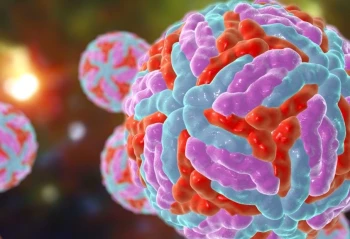How a vaccine can prevent serious birth defects
Laboratory animal research has shown that the Zika virus can cause brain anomalies in unborn babies. Scientists from all over the world are working on a vaccine that will protect future mothers and their unborn babies from Zika virus.
What is Zika virus?
When scientists were investigating yellow fever mosquitoes in Uganda in 1947, they unexpectedly discovered a new virus. They called it Zika virus, after the Zika forest where it was discovered. For a long time, Zika virus stayed under the radar, until it was linked to congenital brain anomalies in newborn children in South America in 2016.

The spread of the Zika virus
The Zika virus is transmitted by the yellow fever mosquito (Aedus Aegypti). Originally, this mosquito was only found in Africa, but it has since spread across all tropical and subtropical regions. Zika virus can thus be 'imported' from any of the areas where the yellow fever mosquito can be found and spread from there, which has now happened in most countries.
Zika fever
Most people infected with Zika virus will not really notice much of their infection. About one in five people will get Zika fever, a relatively mild disease that causes fever, eye infections, rashes and sore muscles. Zika infection during pregnancy, however, can significantly increase the chance of congenital brain anomalies. Furthermore, Zika virus can cause rare neurological complications like Guillain-Barré syndrome.
BPRC research into Zika virus
So far, there is no indication that people can be re-infected with Zika virus, suggesting Zika virus activates the immune system and induces immunological memory. This implies that a vaccine could theoretically prevent Zika virus infection, which is why experimental vaccines need to be evaluated. First, we test it in animal-free laboratory tests and, only once the vaccine meets all the known criteria, in what we call an infection model.
BPRC evaluates experimental Zika virus vaccines in rhesus monkeys. A few weeks after vaccination, we take a blood sample from the animals, which we examine for Zika-specific antibodies. The presence of these antibodies is a first indicator that a vaccine may work. To test if the antibodies are actually effective, the animals are exposed to the virus. This is done under controlled and reproducible conditions, such as a known quantity of virus and at a given point in time.
Rhesus monkeys do not show clinical symptoms after Zika virus infection. The viral load in their blood is therefore an important indicator of the ‘severity’ of the infection. Therefore, we regularly take blood samples to determine Zika virus concentration.
Just like any other scientific experiment, an animal study requires proper controls. Since a virus consists of genetic material surrounded by a protein shell, it cannot exist on its own. Although a virus is not a living being, it can die. In order to prevent drawing false conclusions from an animal study – for example based on dead virus instead of live virus – we include 'control animals' in each study. These animals are not vaccinated before being exposed to the virus.
The efficacy of an experimental vaccine is determined by comparing the viral load in vaccinated animals and control animals. The results of these ‘proof of principle’ studies largely determine if a vaccine candidate will be further developed for human use, or not.
The 3Rs in Zika virus research
Anyone who works with laboratory animals in Europe is required to explain why their research cannot be performed in any other way. Can it be done without using laboratory animals? Or can it be done using fewer animals? Which techniques are available to minimise the discomfort for the laboratory animals? In other words: have the 3Rs been implemented?
Replacement
A vaccine is designed to activate an immunological memory. To evaluate an experimental vaccine, a fully functional immune system is required. In the case of the Zika virus, we currently do not know how this memory is generated and what mechanisms in the immune system are responsible. As such, there is currently no animal-free method to study the interaction between a Zika virus vaccine and the immune system.
Reduction
Only the most promising vaccine candidates are evaluated in animals. Numerous animal-free techniques are used to prevent ineffective or less-effective vaccines from being tested on animals. Combining several vaccine candidates in one study also reduces the number of animals needed.
Refinement
The Netherlands National Committee for the protection of animals used for scientific purposes uses the following definition for the refinement of animal testing: the refinement of animal testing aims to reduce the discomfort of laboratory animals and/or to optimise laboratory animal welfare.
Good living conditions are a key part of our animal welfare policy. At BPRC, animals are always housed in social groups and never alone, and we have an extensive environmental enrichment programme. Furthermore, the animals are trained to reduce stress during experiments.
The rise of HIV and the unprecedented progress in biomedical science go hand in hand, both in terms of technology and animal welfare. As a result, much more data can be collected per animal and their discomfort is minimised.